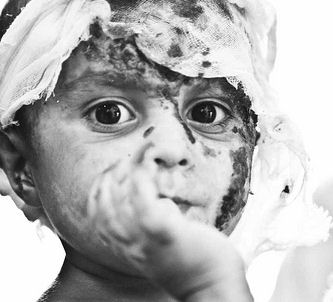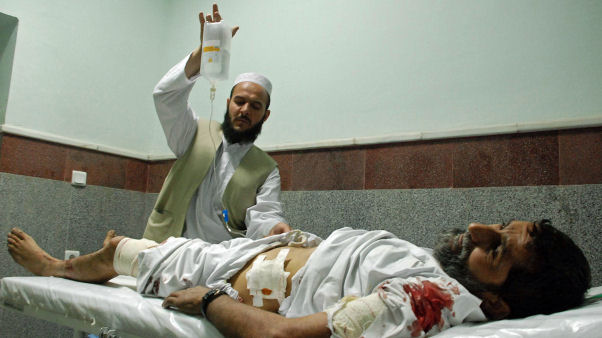Inside an Afghan hospital
Channel 4 News reporter Nima Elbagir went to Afghanistan’s Mirwais hospital to uncover the civilian casualties caught up in the fight between Nato and the Taliban.

In the run up to Afghanistan’s 2009 elections, British forces battled Taliban insurgents in Operation Panther’s Claw, to impose stability in Helmand Province.
Ten British soldiers were killed during Panthers Claw and an estimated 200 Taliban fighters were killed in the heavy fighting. But they were not the only casualties. Many civilians caught up in the crossfire headed to Mirwais hospital – where some had to wait for days before receiving treatment.
A month into the offensive, Channel 4 News reporter Nima Elbagir travelled to the hospital in Kandahar City to witness how civilians were caught up in the fighting.
The following video report contains some distressing images.
Civilian victims of coalition attacks
On the night of July 16, one man said he was asleep in his family home north of Kandahar City. They were woken by a coalition attack on his village.
"It was 10 o'clock at night when I woke up and the helicopters were bombarding.
"So the children and my wife ran outside their rooms and they were fired on by the helicopters.
"I was not with my family at that time - and that's why I survived.
"When I reached them everyone had been injured and then the helicopters fired another bomb."
In another ward next door lies a 13-year-old relative, also injured in the strikes. The young boy was irreversibly brain damaged by one of the missile strikes.
"The doctor said his brain was damaged when he landed on the ground.
"We are being killed and disabled. We don't have a way to get away from these problems.
"The Americans can't recognise who is their friend, and who is their enemy.
"They hurt us civilians.
"They have stolen our comfort."
‘The Americans do not recognise friends from enemies’
When the Obama administrations’ then nominee for the top job in Afghanistan General Stanley McChrystal faced the Senate Armed Services committee in early June 2009 his message was unequivocal – civilian casualties were the major operational issue.
“This is a critical point. It may be the critical point. This is a struggle for the support of the Afghan people.”
Just under a fortnight later the British launched Operation Panther’s Claw in the North of Helmand, quickly followed by the US’s Operation Strike of the Sword to the south. Both designed to clean out the Taliban stronghold that Helmand had become.
A month into Panther’s Claw we travelled to Mirwais Hospital in Kandahar City.
“This is a critical point. It may be the critical point. This is a struggle for the support of the Afghan people.” General Stanley McChrystal
With only 350 beds it serves Afghanistan’s five southern regions – a population of nearly four million. It’s the only hospital in the south with the surgical facilities to treat trauma victims. And it’s where those caught in the operations against the Taliban in Helmand have been coming.
My cameraman Jake and I were both based in Kabul so we were used to hearing the figures on civilian casualties. We went into Mirwais knowing the figures keep rising, we knew this was looking to be the deadliest summer for civilian’s since the conflict began.
But what the statistics conspire to obscure are the numbers of civilians who die because of the war but aren’t felled by a bullet or a bomb.
Although whether McChrystal and the coalition like it, nearly two months after that Senate hearing, most of the patients operated on at Mirwais were there because of bullets and bombs.
On our first day we were taken round by a man who’d lost his grand-daughter in a coalition air strike on his village. Lying next to his bereaved son was another man, naked with his exposed back covered in shrapnel scars. He’d lost his cousin and nephew in another aerial strike on the same night.
And then there was the young man who’d lost his whole family in a US mortar strike.
We spent our first few days in a daze filming a litany of coalition casualties.
None believed they were the unfortunate victims of mistakes or miscalculations – one man told us, “the Americans do not recognise their friends from their enemies.”
But what was unexpected was the children, the dozens and dozens of children, who came in every day.
Unicef rates Afghanistan as having the second highest infant mortality rate in the world and the insecurity plays an ever greater role.
Staff and parents at Mirwais both told us the choice is simple – wait, praying for a window of calm or risk the journey to the hospital through the violence. Wait and risk your child’s life. Go and risk everything.
Fear: the hidden killer
Another side effect of the violence is that people are sometimes too scared to leave their homes to travel to the hospital.
A young toddler is brought in after days of dehydration. The young boy's parents were too afraid to take the journey to Mirwais with the ever present threat of violence.
They waited at home, hoping the child to recover, but when they finally came to the hospital it was too late for doctors to revive him. The child was taken to the mortuary.
It is a common story during the fighting as Dr Sidiq of Mirwais explains: "They're coming in late to us. There is no security so they have to wait till the time they can come.
"Because many times there is fighting on the road, road bombs and these kinds of things."
"So they wait, wait, wait and only in the end stage do they come to us."

We stayed in Kandahar with the International Committee of the Red Cross who support Mirwais. They have the largest expatriate post in Kandahar, an incredibly lonely position to be in. The work they do is incredible.
Unlike many other hospitals in Afghanistan the generator’s never run out of fuel and the medicines are to international standard.
The ICRC trained surgeons are running at capacity, they carry out 700 surgeries a month, of which 600 are on war wounded. And over the next few weeks they are erecting operating theatre tents on the hospital’s grounds to deal with the continuing influx.
Even coming from Kabul, believing that you know a little of the situation on the ground, that you’ve heard the stories elsewhere, you are still unprepared for what you see here.
Victims of aerial bombardment and cross fire, victims of living too near coalition bases or walking down roads the Taliban don’t want built.
Victims of living their life in the middle of a war.
Civilian victims of Taliban attacks
In 2009 over 50 per cent of the deaths caused to civilians was caused by the Taliban, from road side bombs and suicide attacks.
One man was brought in after being caught in an explosion on a road side. He was sweeping for old Soviet-era bombs when an IED (Improvised Explosive Device) exploded.
Although he was treated on the scene by a nearby Afghan National Army paramedic, he died of his wounds by the time he arrived at the hospital.
Another roadside bomb victim was a young boy who was brought in to the hospital after losing both his legs to an IED.
The 11-year-old fruit seller was provided with a three-wheeled wheel chair to allow him to move around, much to his joy. His sheer survival ensured he became a mascot to the elders, who had seen so many other children die.